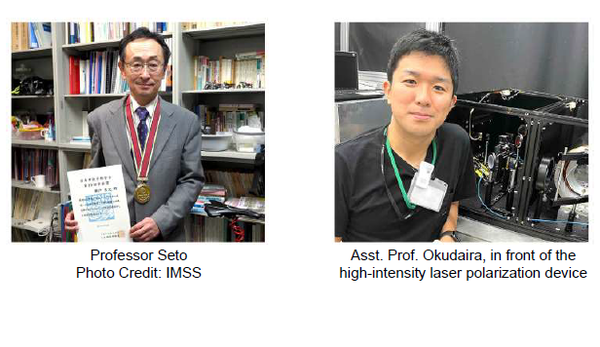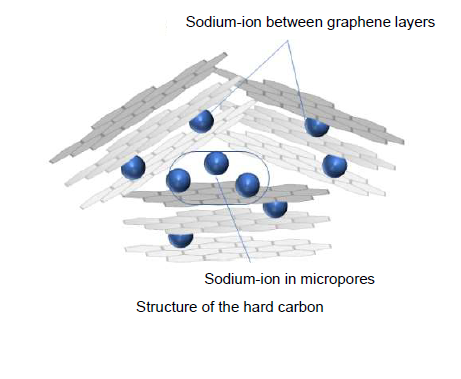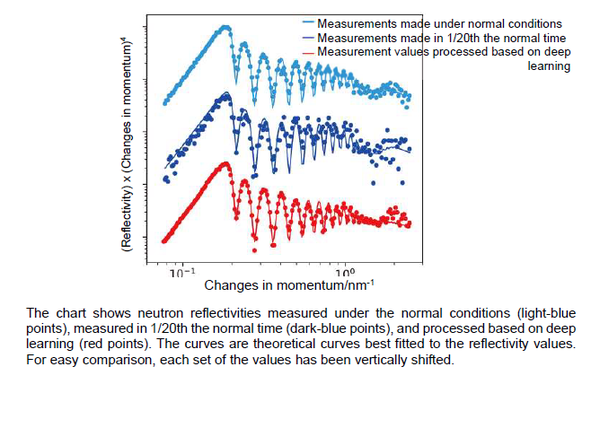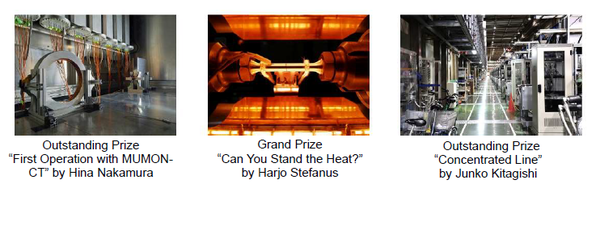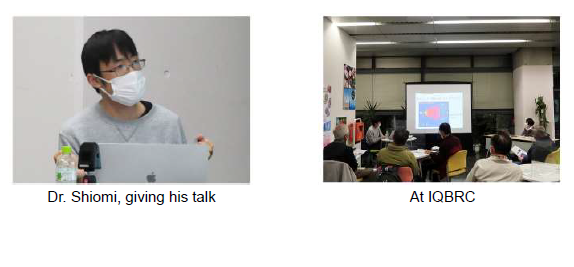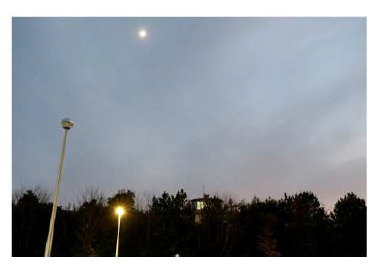J-PARC News December 2021 (Issue #200)
■ J-PARC Center affiliates win awards at 21st annual meeting of Japanese Society for Neutron Science
[Professor Seto receives The JSNS Science Prize]
Professor Hideki Seto, of the Materials and Life Science Division, J-PARC Center and Institute of Materials Structure Science (IMSS), KEK, has won The JSNS Science Prize from the Japanese Society for Neutron Science (JSNS) for his study on “Application and development of neutrons on soft matter science.” This prize is awarded to a full or senior member of the society who has contributed to the progress and development of neutron science that are considered outstanding achievement.
For many years, Professor Seto has contributed to the development and application of neutron instruments that are essential for research activities on soft matter science. At the Materials and Life Science Experimental Facility, J-PARC, he has been involved in the construction of SOFIA, a neutron reflectometer on BL16, and taken a leadership in a proposal to construct VIN ROSE, neutron resonance spin echo spectrometers on BL06. In addition, focusing on the space-time hierarchical structure of soft matter as well as a similarity to life science in mind, he clarified microscopic origins of spontaneous blebbing motion at the oil-water interface by means of small-angle scattering. He also studied and provided basic understanding in the dynamics of hydration water at phospholipid membranes based on quasi-elastic neutron scattering.
[Assistant Professor Okudaira is awarded The JSNS Young Researcher Prize]
Takuya Okudaira, an assistant professor at the Graduate School of Science, Nagoya University and a visiting researcher with the Technology Development Section, J-PARC Center, was awarded The JSNS Young Researcher Prize for his study on the subject “Development of a High-performance 3He Neutron Spin Filter at J-PARC and Leading Research on It.” This prize is awarded to researchers under 40 who have published outstanding research on neutron science.
In conducting research on neutron science, it is very important to develop and improve the performance of neutron polarization devices for aligning neutron spins. In establishing a fabrication process for high-performance spin filters at the MLF and combining it with a high-intensity laser, Asst. Prof. Okudaira has successfully provided a nuclear spin polarization rate close to the theoretical upper limit of 85% and spin relaxation time of 200 hours. He has installed the device on a variety of neutron beam lines at the MLF to demonstrate the ability. Applying his own developed spin filters, he has discovered the bias in the direction of gamma-ray emission due to the absorption reaction of polarized neutrons in nuclei, and has established a polarization analysis method for small-angle neutron scattering.
Drs. Takuya Hosobata and Yutaka Yamagata at the Institute of Physical and Chemical Research were awarded The JSNS Technology Prize for their development of a technique for making a beam line at the MLF.
■Bright prospects for development of negative-electrode materials for sodium ion batteries: Observing diffusion of sodium ions in hard carbon (December 3)
In order to suppress the global climate change, it is crucial to urgently develop and popularize high-performance storage batteries. Because lithium-ion batteries have the problem that the amount of available lithium resources is limited, research is underway on batteries based on sodium, which is an almost inexhaustible resource. In developing high-performance batteries, the point is how fast ions, which carry electricity, can move inside a material, so it is important to determine the self-diffusion coefficient, which is the indicator showing ion mobility. However, with the traditional measurement methods based on electrochemistry, determining material-intrinsic self-diffusion coefficients has not been possible.
Dr. Kazuki Ohishi, associate scientist at the Comprehensive Research Organization for Science and Society (CROSS) and colleagues have successfully determined the self-diffusion coefficient of sodium ions in hard carbon, a candidate negative-electrode material for sodium-ion batteries, by means of muon spin rotation and relaxation (µSR) measurements on the S1 surface beamline (ARTEMIS) at the MUSE MLF of J-PARC. The magnetic properties of muons make it possible to know how sodium nuclei, which are also small magnets, diffuse. They have found although the sodium ions between graphene layers in hard carbon do not diffuse faster than lithium ions in graphite, they can do even at low temperature. They have also observed that sodium ions diffuse not only between graphene layers but also in micropores at above room temperature. These results provide a powerful guide to the development of negative-electrode materials for sodium-ion batteries. In the future, we will also determine the diffusion coefficients of positive-electrode materials and electrolytes toward realizing higher-performance sodium-ion batteries.
■Success in significantly reducing statistical noise through deep learning: Measurement time for neutron experiments has been reduced to less than one tenth, helping with development of new materials, etc. (December 8)
The neutron reflectivity method, a technique for evaluating material surfaces and interfaces, is an effective way to develop functional interfaces in solar cells, lithium batteries, recording materials, adhesives, and so on. However, even the high-intensity neutron beams (capable of applying large numbers of neutrons to samples) at J-PARC require measurement times of several tens of minutes to several hours or longer. As such, conducting more measurements during the neutron facility’s limited operating time requires shortened measurement time. But simply shortening the measurement time will reduce measurement accuracy due to statistical noise. This means we needed a way to take measurements in a short time without sacrificing accuracy.
The developed method makes it possible to extract true signals by removing noise from measurement data.
Hiroyuki Aoki, Senior Principal Researcher and Professor at JAEA and KEK, and colleagues applied deep learning—a machine learning technique—to neutron reflectivity data. Using this approach, the characteristics of the noise that enters data were identified and applied to data obtained through measurements made in 1/20th the normal measurement time with SHARAKU, a neutron reflectometer at J-PARC. As a result, noise was removed (see figure below), and the sample structure obtained though analysis of the data agreed well with the results derived from normal measurement. Consequently, it is possible to shorten measurement time without losing measurement accuracy and to track the process of changes in sample structure, which take place very quickly. In addition, this approach can be applied to scattering experiments and measurement based on X-rays, and is expected to significantly accelerate the use of quantum beams.
■2021 J-PARC Photo Contest
The J-PARC Photo Contest, which is held every autumn, was held this year for the 8th time. We had a total of 21 art works submitted by 13 people who are involved with the operation of J-PARC and J-PARC users. One grand prize, two outstanding prizes, and six runners-up were selected. Two external judges also helped to select them. The award ceremony was held on November 11, and the J-PARC Center Director Takashi Kobayashi handed each award winner a certificate and a gift. First prize was awarded the work “Can You Stand the Heat?” by Harjo Stefanus, Principal Researcher, of the Neutron Use Section. As a photo showing a neutron diffraction experiment conducted at the MLF where a metal sample being heated is tensile-deformed, it was evaluated for the tension and other feelings it radiates. The winning works will be used in various public relations materials.
■J-PARC’s Hello Science lecture on the subject “Difference between matter and antimatter revealed through kaons” (November 26)
As with last month, the lecture was provided at the Ibaraki Quantum Beam Research Center (IQBRC), and was also delivered online. The lecture was given by Dr. Koji Shiomi at the Particle and Nuclear Physics Division, J-PARC Center. Seven people attended the lecture in person, and another 19 viewed it online.
Research to examine the difference in nature between matter and antimatter, i.e., CP violation, deals with an important subject for elucidating the beginning of the universe. This phenomenon, which was discovered in 1964 during kaon decay measurements, was also observed in B meson decay in an experiment conducted at the B factory, KEK, acting as a trigger for the Nobel Prize in Physics awarded to Drs. Kobayashi and Masukawa. With the objective of looking further into CP violation from different perspectives, the KOTO experiment is underway at the hadron facility in J-PARC as the only international joint research in the world designed to pursue the rare phenomenon in which a neutral kaon decays into a neutral π-meson and two neutrinos.The KOTO experiment has already achieved the world’s highest sensitivity, with the result that the probability of the rare decay of neutral kaons is less than 1 in 300 million. After the upgrade of detectors in the fall of 2018, physics data taking was resumed in February 2019, which is expected to be updated with the highest sensitivity. Dr. Shiomi explained the principle of KOTO, the characteristics of the beam line and detector, as well as other topics, and stated expectations about future data.
■Sanpo-michi #18: First-quarter moon floating above the RCS slope: for J-PARC News’s 200th issue anniversary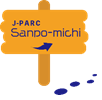
On the slope located on the north side of the RCS accelerator, evergreen broad-leaf trees are growing thick. This place is where a tree-planting ceremony took place in April 2005 under the leadership of the late Akira Miyawaki, who at the time was a professor emeritus at Yokohama National University.
The atmosphere of the ceremony was described in Issue 1 of J-PARC News. On a freshly prepared slope covering 1,600 m2, some 400 participants planted 6,000 seedlings, which over almost 17 years have grown to hide the top of the RCS building.
Having earlier covered topics mainly on the progress of the construction work, J-PARC NEWS has recently been focusing on research results obtained at J-PARC. It is thanks to your understanding and help that J-PARC has grown to this level together with the seedlings planted on the slope. We would like to thank you again.
The first-quarter moon floating above the RCS building has now come and gone about 200 times since we released the first issue of J-PARC News.
Click here to see the J-PARC News #1: http://j-parc.jp/ja/news/2005/news-j0504.html (Only available in Japanese)

